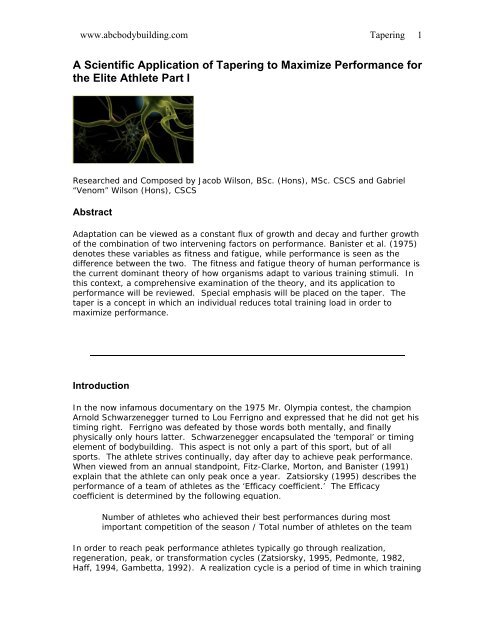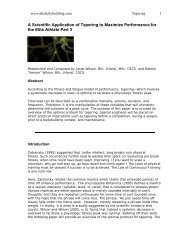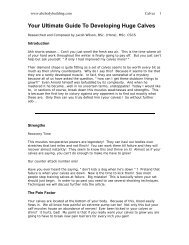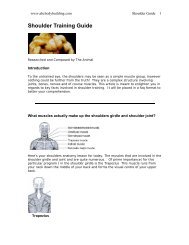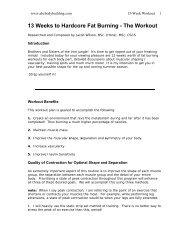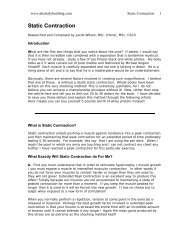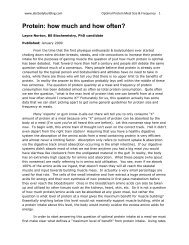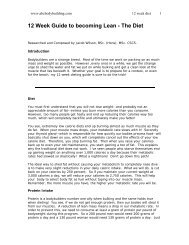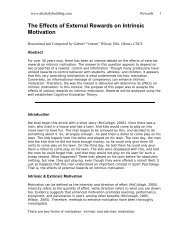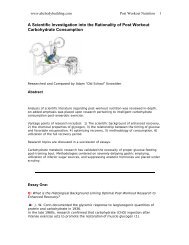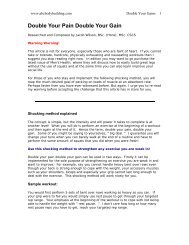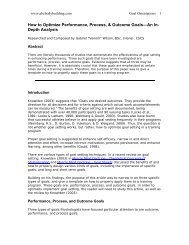A Scientific Application of Tapering to Maximize Performance - ABC ...
A Scientific Application of Tapering to Maximize Performance - ABC ...
A Scientific Application of Tapering to Maximize Performance - ABC ...
Create successful ePaper yourself
Turn your PDF publications into a flip-book with our unique Google optimized e-Paper software.
www.abcbodybuilding.com <strong>Tapering</strong> 1<br />
A <strong>Scientific</strong> <strong>Application</strong> <strong>of</strong> <strong>Tapering</strong> <strong>to</strong> <strong>Maximize</strong> <strong>Performance</strong> for<br />
the Elite Athlete Part I<br />
Researched and Composed by Jacob Wilson, BSc. (Hons), MSc. CSCS and Gabriel<br />
“Venom” Wilson (Hons), CSCS<br />
Abstract<br />
Adaptation can be viewed as a constant flux <strong>of</strong> growth and decay and further growth<br />
<strong>of</strong> the combination <strong>of</strong> two intervening fac<strong>to</strong>rs on performance. Banister et al. (1975)<br />
denotes these variables as fitness and fatigue, while performance is seen as the<br />
difference between the two. The fitness and fatigue theory <strong>of</strong> human performance is<br />
the current dominant theory <strong>of</strong> how organisms adapt <strong>to</strong> various training stimuli. In<br />
this context, a comprehensive examination <strong>of</strong> the theory, and its application <strong>to</strong><br />
performance will be reviewed. Special emphasis will be placed on the taper. The<br />
taper is a concept in which an individual reduces <strong>to</strong>tal training load in order <strong>to</strong><br />
maximize performance.<br />
Introduction<br />
In the now infamous documentary on the 1975 Mr. Olympia contest, the champion<br />
Arnold Schwarzenegger turned <strong>to</strong> Lou Ferrigno and expressed that he did not get his<br />
timing right. Ferrigno was defeated by those words both mentally, and finally<br />
physically only hours latter. Schwarzenegger encapsulated the ‘temporal’ or timing<br />
element <strong>of</strong> bodybuilding. This aspect is not only a part <strong>of</strong> this sport, but <strong>of</strong> all<br />
sports. The athlete strives continually, day after day <strong>to</strong> achieve peak performance.<br />
When viewed from an annual standpoint, Fitz-Clarke, Mor<strong>to</strong>n, and Banister (1991)<br />
explain that the athlete can only peak once a year. Zatsiorsky (1995) describes the<br />
performance <strong>of</strong> a team <strong>of</strong> athletes as the ‘Efficacy coefficient.’ The Efficacy<br />
coefficient is determined by the following equation.<br />
Number <strong>of</strong> athletes who achieved their best performances during most<br />
important competition <strong>of</strong> the season / Total number <strong>of</strong> athletes on the team<br />
In order <strong>to</strong> reach peak performance athletes typically go through realization,<br />
regeneration, peak, or transformation cycles (Zatsiorsky, 1995, Pedmonte, 1982,<br />
Haff, 1994, Gambetta, 1992). A realization cycle is a period <strong>of</strong> time in which training
www.abcbodybuilding.com <strong>Tapering</strong> 2<br />
load is reduced <strong>to</strong> increase performance (Banister, 1999, Gilbala, 1994, Houmard,<br />
1994, Johns, 1992). This process is known as tapering. The taper itself has its roots<br />
in Hull’s (1943) mathematical equation <strong>of</strong> human performance (See Wilson, 2005 for<br />
a review). Wilson (2005) provided the following overview <strong>of</strong> Hull’s contribution:<br />
Hull was the first <strong>to</strong> examine the effect <strong>of</strong> massed practice on performance.<br />
Massed practice can be defined as practice in which work is longer than rest<br />
periods (Schmidt, 1999). In weight training this would entail 1 minute sets,<br />
with only 30 seconds <strong>of</strong> rest between sets. Several reviews on the subject (<br />
Lee and Genovese, 1988, McGeoch and Irion, and Bilodeau and Bilodeau,<br />
1961) provide support for what is known as Hull’s 8 th postulate. Hergenhahn<br />
and Olson (2004) summarize the 8 th postulate as follows:<br />
‘Responding Causes Fatigue, which operates against the elicitation <strong>of</strong> a<br />
conditioned response.’ This is known as reactive inhibition. Reactive inhibition<br />
entails the organism reacting <strong>to</strong> inhibit the action which caused fatigue.<br />
Bourne and Archer (1956) had 5 groups perform a tracking task with 0, 15,<br />
30, 45, and 60 seconds <strong>of</strong> rest. It was found that as rest decreased,<br />
performance decreased. Of particular interest is that performance was<br />
severely depressed in the zero second condition; however, after a day <strong>of</strong> rest,<br />
performance had risen drastically from the end <strong>of</strong> the last trial.<br />
The effect <strong>of</strong> improving in the absence <strong>of</strong> practice is known as reminiscence<br />
(Hergenhahn and Olson, 2004). This effect denoted by Hull provides the<br />
current basis for tapering. According <strong>to</strong> Hull (1943) reactive inhibition was<br />
masking the positive effects <strong>of</strong> practice, and a period <strong>of</strong> rest was needed <strong>to</strong><br />
dissipate this effect. Today, the taper is defined as a period <strong>of</strong> rest, or<br />
lowered training load prior <strong>to</strong> competition meant <strong>to</strong> enhance performance.<br />
Building on the work <strong>of</strong> Hull (1943), Banister et al. (1975) provided a two fac<strong>to</strong>r<br />
mathematical theory on human performance. This theory views the human as a<br />
reactive system which integrates a single input termed training impulse (TRIMP) and<br />
from this produces a single output known as performance (Busso et al., 1997). The<br />
model proposed that the system contained two controls or filters known as first order<br />
transfer functions. These two filters were denoted fitness and fatigue (Banister et<br />
al., 1975, Banister et al., 1985, Banister, 1991, Busso et al., 1991, Mor<strong>to</strong>n et al.,<br />
1990). The fitness represented the positive benefits induced by the training impulse,<br />
while the fatigue represented the negative effects <strong>of</strong> training. <strong>Performance</strong> was<br />
suggested <strong>to</strong> be a second order transfer function, and could be calculated by the<br />
difference between Fitness and Fatigue:<br />
<strong>Performance</strong> = Fitness – Fatigue<br />
The fitness fatigue model is based on the principle <strong>of</strong> parsimony. The principle <strong>of</strong><br />
parsimony states that given two models with equal predictive value, the more<br />
simplistic <strong>of</strong> the two should be utilized. Banister (1991) explains: “ To be effective<br />
the conjecture must be simple yet elegant. The criterion used in modeling behavior<br />
<strong>of</strong> even complex systems in engineering is <strong>to</strong> invoke as few elements (black box<br />
unknowns) as possible. These elements interact, enabling one <strong>to</strong> explain the<br />
dynamic working behavior <strong>of</strong> the system. Parsimony is achieved in the process <strong>of</strong><br />
modeling and predicting the results by allowing only two elements <strong>to</strong> contribute <strong>to</strong>
www.abcbodybuilding.com <strong>Tapering</strong> 3<br />
performance, each element being precisely specific and derived from a single<br />
quantitative measurement <strong>of</strong> training contained in the training impulse score.”<br />
Training Impulse ( w(t) )<br />
The main goal <strong>of</strong> the two fac<strong>to</strong>r theory is <strong>to</strong> predict human performance in a dose<br />
dependent fashion. While 30 years <strong>of</strong> modeling modifications have been made (<br />
Mujika, 2002 ) the gross equation for training impulse (TRIMP) is as follows<br />
TRIMP = Training Intensity * Duration<br />
Banister et al. (1975) proposed that heart rate was the most stable reflection <strong>of</strong><br />
intensity, as a participant training at the same rate along the same route has a<br />
remarkably consistent heart rate (Banister, 1991). The amplitude or intensity was<br />
then multiplied by the duration in minutes that the activity occurred. The exact<br />
equation is as follows<br />
TRIMP = Duration * (Heart Rate exercise – heart rate rest) / (Heart rate maximum –<br />
heart rate rest)<br />
Note that the equation only includes beats above that which occur during rest.<br />
Therefore, it takes in<strong>to</strong> account only the extra beats needed <strong>to</strong> perform exercise, not<br />
the beats needed <strong>to</strong> maintain a resting energy output. Heart Rate exercise – Heart<br />
Rate Rest is known as ‘Span Heart Rate’ while Heart rate maximum (found by<br />
subtracting the participants age from 220 ) – Heart rate rest is known as Delta Heart<br />
Rate(Banister, 1991). In abbreviated terms the equation can be written as follows<br />
w(t) = Tim(min) * Delta Heart Rate Ratio<br />
Another fac<strong>to</strong>r <strong>to</strong> take in<strong>to</strong> account is that the intensity <strong>of</strong> an exercise bout does not<br />
produce linear changes in the human body. Linear simply means that as intensity<br />
increases the body is stressed in a uniform manner. That is, for every point that<br />
intensity increases, the stress placed on the body increases by one point. This does<br />
not occur. To show this, Mortin et al. (1990) used work done on the lactate response<br />
curve by Green et al. (1983) <strong>to</strong> weight intensity. The work done by Green et<br />
al.(1983) found that lactate rises with two break points or sharp rises in which lactic<br />
acid accumulates in an exponential fashion <strong>to</strong> intensity. These breakpoints are<br />
known as lactate threshold 1 and 2.
www.abcbodybuilding.com <strong>Tapering</strong> 4<br />
In this context, it would be misleading <strong>to</strong> treat intensity increases as affecting the<br />
system in a uniform manner. Instead, a weighting fac<strong>to</strong>r was calculated which<br />
increased according <strong>to</strong> the lactic acid curve. This way, higher intensities would yield<br />
larger than linear increases in the training dose. The same effect <strong>of</strong> intensity on<br />
lactic acid can be found in numerous hormonal increases during exercise (King,<br />
2003, Wilson, 2004, Wilson and Wilson, 2005, a, b, c, d)<br />
Other training doses have also been calculated. For example Mujika et al. (1996a)<br />
used lactic acid build up <strong>to</strong> denote intensity. They formulated five different<br />
intensities based on lactic acid concentration in the body. And each intensity was<br />
weighted higher than the previous intensity.<br />
The training dose is calculated for each variation within a training session, and then<br />
summed <strong>to</strong> yield the <strong>to</strong>tal dose for that session (Banister, 1991). For example, if a<br />
participant is interval training on the treadmill they may begin with a 10 minute<br />
warm up at 120 beats per minute, followed by 10 minutes at 140 beats, followed by<br />
10 at 160 beats. The TRIMP would be calculated for each interval and then added<br />
<strong>to</strong>gether. Likewise consecutive training days could be added in this fashion.<br />
Utilizing The Training Dose To Predict <strong>Performance</strong><br />
Once the training impulse, denoted w(t) has been calculated, the fitness impulse<br />
denoted p(t) and the fatigue impulse denoted f(t) can be calculated. On the basis <strong>of</strong><br />
numerous studies the model predicts that the amplitude is approximately twice as<br />
high for the fatigue impulse than the fitness impulse (Banister, 1991, Fitz-Clarke,<br />
1991, Mujika, 1996, Zatsiorsky, 1995). Therefore calculations are as follows:<br />
p(t) = K1w(t) and f(t) = K2w(t)<br />
The equation states that the effect <strong>of</strong> the fitness impulse p(t) is found by multiplying<br />
the training dose w(t) by a weighting fac<strong>to</strong>r denoted K1, where K1 is equal <strong>to</strong> 1.<br />
Therefore if the training dose is 1 unit then p(t) would also equal 1. However,<br />
fatigue is multiplied or weighted by K2, which is equal <strong>to</strong> 2, suggesting that the<br />
fatigue impulse is twice the fitness impulse. This would explain why after a training<br />
session that performance drops <strong>of</strong>f <strong>to</strong> such a notable extent, as the fatigue produced<br />
by the training dose is at a much higher amplitude then the fitness produced.<br />
Before continuing, recall Hull’s (1943) work on reactive inhibition. He noted<br />
participants performance decreased during massed practice. However, after a period<br />
<strong>of</strong> rest, in the absence <strong>of</strong> practice their performance had increased (reminiscence).<br />
He postulated that the rest allowed the participant <strong>to</strong> dissipate the reactive<br />
inhibition, while maintaining positive gains. From this it can be deduced that fitness,<br />
though at a lower amplitude then fatigue, has a more stable decay constant.<br />
Banister (1991) and Fitz-Clarke et al. (1991) from numerous studies, including<br />
fitness fatigue models on strength athletes (Busso et al., 1990 ) have calculated the<br />
average decay constant for fitness <strong>to</strong> be 45 days, while the fatigue decay constant<br />
on average was 15 days. The decay constant denotes the time it takes for a value <strong>to</strong><br />
decrease by 37 %. Therefore, it is predicted that a period <strong>of</strong> rest (taper) takes<br />
advantage <strong>of</strong> a rapidly decaying fatigue impulse <strong>to</strong> unmask the underlying fitness<br />
component. In this context, adaptation is said <strong>to</strong> be viewed as a constant flux <strong>of</strong><br />
growth and decay and further growth <strong>of</strong> the combination <strong>of</strong> two intervening fac<strong>to</strong>rs<br />
on performance.
www.abcbodybuilding.com <strong>Tapering</strong> 5<br />
Such a process also explains a phenomenon known as delayed transformation <strong>of</strong><br />
gains (Hartmann, 1989, Plisk et al., 2003, Verkhoshansky, 1986, 1988, Zatsiorsky,<br />
1995). In this context, an athlete may reach a plateau and increase work load, which<br />
leads <strong>to</strong> a further increase in gains. Once a plateau is hit, workload is increased<br />
again, but gains do not follow. The athlete then decreases workload, <strong>to</strong> take<br />
advantage <strong>of</strong> the decay <strong>of</strong> fatigue <strong>to</strong> reveal the gains that were masked (delayed<br />
transformation <strong>of</strong> gains).<br />
Models Prediction on Duration <strong>of</strong> the Taper<br />
The taper is based on two further functions predicted by the model. The first is<br />
defined as tn, which is the critical time before a competition in which training can<br />
contribute positively <strong>to</strong> performance at a specific date ( Mujika et al., 1996, Fitz-<br />
Clark et al., 1991). Given the decay constants <strong>of</strong> 15 and 45 days for fatigue and<br />
fitness, Fitz-Clarke (1991) calculated tn or the threshold for training benefits <strong>to</strong> be<br />
16 +/-6 days. The second function is denoted tg and is defined as ‘the time before<br />
competition necessary <strong>to</strong> reach a maximal benefit from training (Mujika et al.,<br />
1996).’ Given the same constants, FItz-Clarke et al. (1991) calculated tg <strong>to</strong> be 40<br />
+/- 8 days. In this context, the taper should occur between the time when training<br />
results in maximal performance (tg) and the time when training contributes<br />
negatively <strong>to</strong> performance tn. Fitz-Clark et al. found this <strong>to</strong> be between 16 +/- 6<br />
and 40 +/-8 days.<br />
The Models Predictive Value and Optimal Duration for <strong>Tapering</strong><br />
Ultimately the numbers for decay constants, and amplitudes <strong>of</strong> first order functions<br />
have been derived from numerous studies (Banister, 1991, Fitz-Clark, 1991).<br />
However, authors <strong>of</strong> the models also explain that their predictive value must take<br />
in<strong>to</strong> account each athlete individually (Banister, 1991, Mujika et al., 1996). For this<br />
<strong>to</strong> occur, each athletes’ training impulse and predicted performance values are<br />
typically plotted against actual performance (Banister, 1991, Mujika et al., 1996).<br />
When done this way, decay constants can be adjusted <strong>to</strong> the actual individual.<br />
Mujika et al. (1996) investigated a predictive model on swim performance in elite<br />
swimmers based on a modified version <strong>of</strong> the Banister (1975) model and found that<br />
predicted values could account for up <strong>to</strong> 85 % <strong>of</strong> performance. When plotting actual<br />
values, they found that the mean or average decay constant for fitness was 40 days,<br />
which is very close <strong>to</strong> the predicted 45 day value, and that the fatigue decay<br />
constant was 12 days on average, again close <strong>to</strong> the 15 day predicted value in the<br />
Fitz-Clark (1991) and Banister (1991) studies. Further these investiga<strong>to</strong>rs found tn<br />
and tg, <strong>to</strong> be between 12 ± 6 and 32 ± 12 d for the group <strong>of</strong> swimmers. Again this<br />
is close <strong>to</strong> the predicted values in the Fitz-Clarke (1991) study, as well others (Johns<br />
et al., 1992, Banister et al., 1985, Calvert et al., 1976, Mor<strong>to</strong>n et al., 1990 ) .<br />
The investiga<strong>to</strong>rs also examined the effects <strong>of</strong> three tapers utilized by the swimmers<br />
during the season. The first lasted for 14 days, the second for 21 days, and the third<br />
for 41 days. The athletes increased performance by 3 percent in both the 14 and 21<br />
day tapers, but did not get significant increases in the 41 day taper. In another<br />
study, Martin et al. (1994) had participants perform 6 weeks <strong>of</strong> high intensity aerobic<br />
training, followed by a 14 day taper. It was found that cycling performance<br />
increased by 8% and QUAD strength increased by 8-9%. In another study,<br />
Zarkadas et al. (1995) investigated the effect <strong>of</strong> a 10 day and 13 day taper<br />
interspersed between 3 months <strong>of</strong> intense training in triathletes. In the 10 day
www.abcbodybuilding.com <strong>Tapering</strong> 6<br />
taper, a 4% improvement was found in their 5 km criterion run and a 6 % increase<br />
In the 13 day taper. The greater results in the 13 day taper may reflect a longer<br />
time period <strong>to</strong> dissipate the fatiguing impulse. Mujika et al. (1996b) investigated the<br />
effect <strong>of</strong> a 28 day taper following 12 weeks <strong>of</strong> intense training in elite swimmers. It<br />
was found that performance decreased slightly during the most intense aspect <strong>of</strong> the<br />
12 weeks by .5 %, but increased by nearly 2.5 % during the taper. Trappe et al.<br />
(2000) and Trappe et al. (2001) found that 21 day tapers in elite swimmers elicited<br />
an increase in power, swim performance, and muscular size. In another study,<br />
participants were placed on an elbow flexor strength training program for three<br />
weeks followed by a 10 day taper. It was found that maximum voluntary contraction<br />
increased significantly in all participants (Gibala, 1994).<br />
From the above data, it can be seen that significant increases in performance ranged<br />
from 10 – 28 day tapers. However, the range has extended even further with<br />
increases seen from 10-35 days in swimmers (Mujika et al., 2003) and as low as six<br />
<strong>to</strong> seven in runners ( Mujika et al., 2000, MUjaka et al., 2002, Shepley et al., 1992).<br />
These data roughly fall within the ranges found in the Mujika (1996) study in which<br />
the optimal taper ranged from 12-32 days, as well as the estimates by Fitz-Clark<br />
(1991) who found the optimal tapers <strong>to</strong> be between 16 +/- 6 and 40 +/- 8 days.<br />
Current evidence suggests that the optimal taper duration be decided based on past<br />
training length and intensity (Kubukeli et al. 2002, Zatsiorsky, 1995). While the<br />
exact duration <strong>of</strong> taper which elicits a detraining effect is not precisely known (<br />
Mujaki, 2000), Kubukely et al. (2002 ) suggests that both intensity and duration <strong>of</strong><br />
previous training effect the time needed <strong>to</strong> dissipate fatigue. These investiga<strong>to</strong>rs<br />
suggest a minimum <strong>of</strong> a 2 week taper for extremely hard and long previous training,<br />
with lower periods ( i.e. 6-10 days) for lower volume, and duration training phases.<br />
Similarly, Zatsiorsky (1995) suggests that tapers should last for 4 +/- 2 weeks, with<br />
training phases containing numerous shock cycles on the upper end, and lower<br />
volume moderate training phases on the lower end.<br />
A Clearer Look at Fitness and Fatigue<br />
In the Mujika (1996) study on elite swimmers, both the 14 and 21 day tapers<br />
produced a 3 % increase in performance. Fitness in this study was denoted PI and<br />
summated all fac<strong>to</strong>rs contributing <strong>to</strong> increased performance, where as fatigue<br />
denoted NI was a summation <strong>of</strong> all fac<strong>to</strong>rs contributing <strong>to</strong> decreased performance.<br />
Statistical analysis among first order functions found a significant decrease in NI<br />
during the first two tapers, with no significant increase or decrease in PI. This again<br />
supports the Hull (1943) reactive inhibition, and Banister (1975) two fac<strong>to</strong>r theory.<br />
Fitness and fatigue in modeled studies are examined on various parameters, such as<br />
hormonal concentrations ( Busso et al., 1990, Busso et al., 1992). One <strong>of</strong> the major<br />
determinants used is the tes<strong>to</strong>sterone <strong>to</strong> cortisol ratio ( Adlercreutz et al., 1986,<br />
S<strong>to</strong>ne et al., 1991 ). A decrease in the tes<strong>to</strong>sterone <strong>to</strong> cortisol ratio is associated<br />
with fatigue, while an increase is associated with fitness (Fry et al. 2000). Therefore,<br />
an increase in performance can occur with an increase in tes<strong>to</strong>sterone (fitness) or a<br />
decrease in cortisol (dissipation <strong>of</strong> fatigue) levels (Busso et al., 1992, Mujika et al.,<br />
1996, Mujika et al. 1996b). Briefly, tes<strong>to</strong>sterone is associated with anabolism, while<br />
cortisol is associated with catabolism ( King 2002, Wilson and Wilson 2005). In this<br />
context, Busso et al. (1992) modeled the performance <strong>of</strong> elite weight lifters during a<br />
four week intense training phase, followed by a two week taper. During the four
www.abcbodybuilding.com <strong>Tapering</strong> 7<br />
week intense training program tes<strong>to</strong>sterone levels decreased, and this was<br />
significantly correlated with fatigue. However, lutinzing hormone concentrations also<br />
increased and were significantly correlated with increases in fitness ( r = .9, meaning<br />
that 81 % <strong>of</strong> the increase in lutinzing hormone was in common with predicted<br />
increases in fitness). During the two week taper, tes<strong>to</strong>sterone levels increased along<br />
with increased performance, and this was highly correlated (r = .97) with the<br />
increased lutinzing hormone concentration seen in the four week period. Again, this<br />
lends support <strong>to</strong> the two fac<strong>to</strong>r theory. King (2003) explains that lutinzing hormone<br />
stimulates an increase in tes<strong>to</strong>sterone levels. In another investigation Hakkinen et<br />
al. (1987) found significant increases in cortisol during a 4 week intensive training<br />
cycle with a concomitant decrease in the tes<strong>to</strong>sterone/cortisol ratio. However, after<br />
a two week taper cortisol levels decreased (fatigue was dissipated) which increased<br />
the tes<strong>to</strong>sterone / cortisol ratio. Similarly Mujika et al. (1996b) investigated the<br />
tes<strong>to</strong>sterone / cortisol ratio during 12 weeks <strong>of</strong> intense training and 4 weeks <strong>of</strong><br />
tapering in elite swimmers. <strong>Performance</strong> slightly decreased during the 12 weeks and<br />
this was significantly correlated <strong>to</strong> a decrease in the tes<strong>to</strong>sterone / cortisol ratio,<br />
while performance increased during the taper, and was correlated with an increase in<br />
the tes<strong>to</strong>sterone / cortisol ratio.<br />
Wilson (2003) in his investigation in<strong>to</strong> precompetition carbohydrate depleting and<br />
replenishing strategies also provided support for the fitness and fatigue model. To<br />
summarize his research, 6 days before a contest bodybuilders deplete glycogen<br />
s<strong>to</strong>res through high volume training and low carbohydrate diets. During this phase<br />
glycogen is depleted and this represents fatigue. However, simultaneously an<br />
enzyme known as glycogen synthase which is responsible for glycogen formation<br />
increases in activity. Following the 3 days <strong>of</strong> depletion, training is lowered and<br />
carbohydrates are increased. During this time glycogen is replenished rapidly <strong>to</strong> the<br />
point where it reached pre depletion stages. This represents a dissipation <strong>of</strong> fatigue;<br />
however, the fitness gain remains longer ( its decay constant is slower) as glycogen<br />
synthase activity is still high, leading <strong>to</strong> 3-5 times the original levels <strong>of</strong> muscle<br />
glycogen saturation.<br />
Summary<br />
Banister et al. (1975) suggested that an organism should be viewed as a system<br />
which receives input in the form <strong>of</strong> training, and produces output in the form <strong>of</strong><br />
performance. The model suggests that the duration and intensity <strong>of</strong> training, termed<br />
training impulse, effects the system by causing a fatiguing and fitness effect. In this<br />
context, performance is calculated by subtracting the negative fatiguing impulse<br />
from the positive fitness impulse.<br />
Generally fatigue is thought <strong>to</strong> have a two fold higher initial amplitude or effect on<br />
the organism than fitness. However, the positive fitness adaptations obtained from<br />
the training impulse last three times longer than the fatigue. <strong>Tapering</strong> pro<strong>to</strong>cols are<br />
implemented <strong>to</strong> take advantage <strong>of</strong> the differences in these decay constants.<br />
Because fatigue dissipates faster than fitness, a relatively short period <strong>of</strong> lowered<br />
volume in training can remove the fatigue, while maintaining positive adaptations.<br />
Jacob Wilson<br />
President Abcbodybuilding / The Journal <strong>of</strong> HYPERplasia Research
www.abcbodybuilding.com <strong>Tapering</strong> 8<br />
jwilson@abcbodybuilding.com<br />
Gabriel “Venom” Wilson<br />
Executive <strong>of</strong> Bioenergetic Research<br />
Venom@abcbodybuilding.com<br />
References and Sources Cited<br />
Adlercreutz, H., M. Härkönen, K. Kuoppasalmi, H. Nveri, I. Huhtaniemi, H. Tikkanen,<br />
K. Remes, A. Dessypris, and J. Karvonen. Effect <strong>of</strong> training on plasma anabolic and<br />
catabolic steroid hormones and their response during physical exercise. Int. J. Sports<br />
Med. 7(Suppl):27–28. 1986.<br />
Banister, E. W., Calvert, T. W., Savage, M. V. (1975) A systems model <strong>of</strong> training for<br />
athletic performance. J. Sports. Med. 7, p.57-61.<br />
Busso, Thierry, Christian Denis, Re´gis Bonnefoy, Andre´ Geyssant, and Jean-Rene´<br />
Lacour. Modeling <strong>of</strong> adaptations <strong>to</strong> physical training by using a recursive least<br />
squares algorithm. J. Appl. Physiol. 82(5): 1685–1693, 1997<br />
Banister, E. W. and C. L. Hamil<strong>to</strong>n. Variations in iron status with fatigue modelled<br />
from training in female distance runners.Eur. J. Appl. Physiol. 54:16-23, 1985<br />
Busso, T., R. Candau, and J. R. Lacour. Fatigue and fitness modelled from the effects<br />
<strong>of</strong> training on performance. Eur. J. Appl. Physiol. 69:50-54, 1994.<br />
Busso, T., C. Carasso, and J. R. Lacour. Adequacy <strong>of</strong> a systems structure in the<br />
modeling <strong>of</strong> training effects on performance.J. Appl. Physiol. 71:2044-2049, 1991.<br />
Calvert, T. W., E. W. Banister, M. V. Savage, and T. Bach. A systems model <strong>of</strong> the<br />
effects <strong>of</strong> training on physical performance.IEEE Trans. Syst. Man. Cybernet. 6:94-<br />
102, 1976.
www.abcbodybuilding.com <strong>Tapering</strong> 9<br />
Gibala, M. J., J. D. Macdougall, and D. G. Sale. The effects <strong>of</strong> tapering on strength<br />
performance in trained athletes. Int. J. Sports. Med. 15: 492-497, 1994.<br />
S<strong>to</strong>ne, M.H., R.E. Keith, J.T. Kearney, S.J. Fleck, G.D. Wilson, and N.T. Triplett.<br />
Overtraining: a review <strong>of</strong> the signs, symp<strong>to</strong>ms, and possible causes. J. Appl. Sports<br />
Sci. Res. 5:35–50. 1991.<br />
MUJIKA, IÑIGO; BUSSO, THIERRY; LACOSTE, LUCIEN; BARALE, FRÉDÉRIC;<br />
GEYSSANT, ANDRÉ; CHATARD, JEAN-CLAUDE Modeled responses <strong>to</strong> training and<br />
taper in competitive swimmers Medicine & Science in Sports & Exercise: Volume<br />
28(2) February 1996 pp 251-258<br />
Fitz-Clarke, J. R., R. H. Mor<strong>to</strong>n, and E. W. Banister. Optimizing athletic performance<br />
by influence curves. J. Appl. Physiol. 71:1151-1158, 1991.<br />
Steven S. Plisk, Strength and Conditioning Journal: Vol. 25, No. 6, pp. 19–37.<br />
Hartmann, J., and H. Tünnemann. Fitness and Strength Training. Berlin: Sportverlag.<br />
1989.<br />
Mujika, I., A. Goya, S. Padilla, A. Grijalba, E. Gorostiaga, and J. Ibañez. Physiological<br />
responses <strong>to</strong> a 6-day taper in middle-distance runners: influence <strong>of</strong> training intensity<br />
and volume. Med. Sci. Sports Exerc. 32: 511-517, 2000.<br />
Mujika, I., A. Goya, E. Ruiz, A. Grijalba, J. Santisteban, and S. Padilla. Physiological<br />
and performance responses <strong>to</strong> a 6-day taper in middle-distance runners: influence <strong>of</strong><br />
training frequency. Int. J. Sports Med. 23: 367-373, 2002.
www.abcbodybuilding.com <strong>Tapering</strong> 10<br />
Kubukeli, Z. N., T. D. Noakes, and S. C. Dennis. Training techniques <strong>to</strong> improve<br />
endurance exercise performances. Sports Med. 32: 489-509, 2002.<br />
Banister, E. W. Modeling elite athletic performance. In:Physiological Testing <strong>of</strong> Elite<br />
Athletes, H. J. Green, J. D. McDougal, and H. Wenger (Eds.). Champaign, IL: Human<br />
Kinetics Publishers, 1991, pp. 403-424.<br />
Busso, T., K. Hakkinen, A. Pakarinen, ET AL. A systems model <strong>of</strong> training responses<br />
and its relationships <strong>to</strong> hormonal responses in elite weight-lifters. Eur. J. Appl.<br />
Physiol. 61:48-54, 1990.<br />
Busso, T., K. Hakkinen, A. Pakarinen, H. Kauhanen, P. V. Komi, and J. R. Lacour.<br />
Hormonal adaptations and modelled responses in elite weightlifters during 6 weeks<br />
<strong>of</strong> training. Eur. J. Appl. Physiol. 64:381-386, 1992.<br />
Hakkinen K, Pakarinen A, Alen M, Kauhanen H, Komi PV. Relationships between<br />
training volume, physical performance capacity, and serum hormone concentrations<br />
during prolonged training in elite weight lifters. Int J Sports Med. 1987 Mar;8 Suppl<br />
1:61-5.<br />
Fry et al. (2000) relationship between serum tes<strong>to</strong>sterone, cortisol, and weightlifting,<br />
Journal <strong>of</strong> Strength and Conditioning<br />
Pedemonte, J. 1982: Updated Acquisitions About Training Periodization: Part One.<br />
National Strength Coaches Association Journal: Vol. 4, No. 5, pp. 56–60.<br />
Haff, G. PhD, CSCS. 2004: Roundtable Discussion: Periodization <strong>of</strong> Training—Part 1.<br />
Strength and Conditioning Journal: Vol. 26, No. 1, pp. 50–69.
www.abcbodybuilding.com <strong>Tapering</strong> 11<br />
Gambetta, V. 1991: PRINCIPLES OF PROGRAM DESIGN: Some thoughts on new<br />
trends in training theory. National Strength & Conditioning Association Journal: Vol.<br />
13, No. 1, pp. 24–26.<br />
Banister, E. W., J. B. Carter, and P. C. Zarkadas. Training theory and taper:<br />
validation in triathlon athletes. Eur. J. Appl. Physiol. 79: 182-191, 1999.<br />
Houmard, J. A., and R. A. Johns. Effects <strong>of</strong> taper on swim performance: practical<br />
implications. Sports Med. 17: 224-232, 1994.<br />
Johns, R. A., J. A. Houmard, R. W. Kobe, et al. Effects <strong>of</strong> taper on swim power,<br />
stroke distance and performance. Med. Sci. Sports Exerc. 24: 1141-1146, 1992<br />
GREEN, H. J., R. L. HUGHSON, G. W. ORR, AND D. A. RANNEY. Anaerobic threshold,<br />
blood lactate and muscle metabolites in progressive exercise. J. Appl. Physiol. 54:<br />
1032-1038, 1983.<br />
King, J. Endocrine insanity. Journal <strong>of</strong> Hyperplasia Research. June, 2003<br />
Kubukeli, Z. N., T. D. Noakes, and S. C. Dennis. Training techniques <strong>to</strong> improve<br />
endurance exercise performances. Sports Med. 32: 489-509, 2002.<br />
Mujika, I., J. C. Chatard, S. Padilla, C. Y. Guezennec, and A. Geyssant. Hormonal<br />
responses <strong>to</strong> training and its tapering <strong>of</strong>f in competitive swimmers: relationships with<br />
performance. Eur. J. Appl. Physiol. 74: 361-366, 1996. b<br />
Mujika, I., J. C. Chatard, and A. Geyssant. Effects <strong>of</strong> training and taper on blood<br />
leucocyte populations in competitive swimmers: relationships with cortisol and<br />
performance. Int. J. Sports Med. 17: 213-217, 1996. c<br />
Mor<strong>to</strong>n, R. H., J. R. Fitz-Clarke, and E. W. Banister. Modeling human performance in<br />
running. J. Appl. Physiol. 69: 1171-1177, 1990
www.abcbodybuilding.com <strong>Tapering</strong> 12<br />
Mujika, I., A. Goya, S. Padilla, A. Grijalba, E. Gorostiaga, and J. Ibañez. Physiological<br />
responses <strong>to</strong> a 6-day taper in middle-distance runners: influence <strong>of</strong> training intensity<br />
and volume. Med. Sci. Sports Exerc. 32: 511-517, 2000.<br />
Neufer, P. D. The effect <strong>of</strong> detraining and reduced training on the physiological<br />
adaptations <strong>to</strong> aerobic exercise training. Sports Med. 8: 302-321, 1989.<br />
Shepley, B., J. D. Macdougall, N. Cipriano, J. R. Sut<strong>to</strong>n, M. A. Tarnopolsky, and G.<br />
Coates. Physiological effects <strong>of</strong> tapering in highly trained athletes. J. Appl. Physiol.<br />
72: 706-711, 1992.<br />
Trappe, S., D. Costill, and R. Thomas. Effect <strong>of</strong> swim taper on whole muscle and<br />
single fiber contractile properties. Med. Sci. Sports Exerc. 32: 48-56, 2001.<br />
Trappe S, Costill D, Thomas R. Effect <strong>of</strong> swim taper on whole muscle and single<br />
muscle fiber contractile properties.Med Sci Sports Exerc. 2000 Dec;32(12):48-56.<br />
Verkhoshansky, Y.V. Fundamentals <strong>of</strong> Special Strength-Training in Sport. Livonia,<br />
MI: Sportivny Press. 1986.<br />
Verkhoshansky, Y.V. Programming and Organization <strong>of</strong> Training. Livonia, MI:<br />
Sportivny Press. 1988.<br />
Wilson, J., and Wilson, G., Fast Acting Hormones and their Role in Fuel use during<br />
Exercise. Journal <strong>of</strong> Hyperplasia Research. January, 2005. (a)<br />
Wilson, J., and Wilson, G., Slow Acting Hormones and their Role in Fuel use during<br />
Exercise. Journal <strong>of</strong> Hyperplasia Research. January, 2005. (b)
www.abcbodybuilding.com <strong>Tapering</strong> 13<br />
Wilson, J., and Wilson, G., Analysis <strong>of</strong> Nutrient use during Low, Moderate, and High<br />
Intensity Exercise. Journal <strong>of</strong> Hyperplasia Research. January, 2005. (c)<br />
Wilson, J., and Wilson, G., Direct Comparisons <strong>of</strong> Fuel use during Low, Moderate, and<br />
High Intensity Exercises. Journal <strong>of</strong> Hyperplasia Research. January, 2005. (d)<br />
Wilson, J. Exercise Endocrinology Principles and Catecholamines. Journal <strong>of</strong><br />
Hyperplasia Research. January, 2004<br />
Zarkadas, P. C., J. B. Carter, and E. W. Banister. Modelling the effect <strong>of</strong> taper on<br />
performance, maximal oxygen uptake, and the anaerobic threshold in endurance<br />
triathletes. Adv. Exp. Med. Biol. 393: 179-186, 1995.<br />
Zatsiorsky, V.M. Science and Practice <strong>of</strong> Strength Training. Champaign, IL: Human<br />
Kinetics, 1995.<br />
© <strong>ABC</strong> Bodybuilding Company. All rights reserved. Disclaimer


